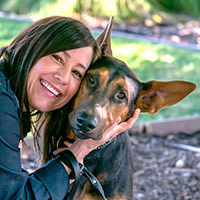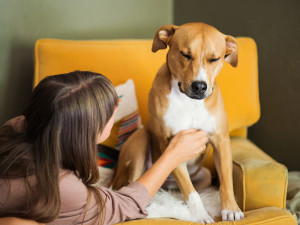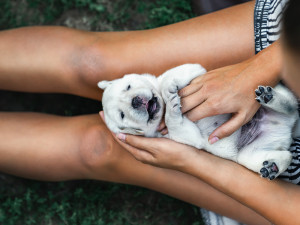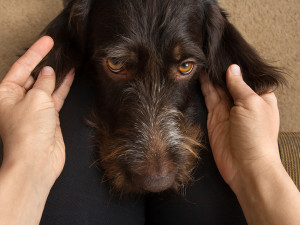DIY Pet Physical Exam: How to Check Your Dog’s Breathing & Skin
Veterinarian Dr. Shea Cox on how to get comfortable checking your dog’s breathing, respiratory rate, and skin hydration.

share article

Your pet wants you to read our newsletter. (Then give them a treat.)
In this series, we’re helping pet parents gain confidence in conducting basic health checksopens in a new tab on their dogs. This installment will show you how to examine your dog’s chest, known as the thorax, at home.
To properly examine your dog’s thorax, you’ll learn how to: check their neck, assess their chest, learn how to measure a dog’s respiratory rate and perform a skin turgor test, which determines how hydrated your pup is. In the next part of our series, we will continue with the dog’s abdomen. At the completion of this series of articles, you should feel totally prepared to perform a screening exam on your dog.
How to Check Your Dog’s Respiratory Rate
When your dog is sleeping, or resting quietly, you can assess their respiratory rate. First, watch your dog's chest as it rises and falls to familiarize yourself with the movement. One breath is counted when the dog has inhaled and exhaled once. Next, set a timer for 30 seconds. Count the number of times the dog takes a breath (when the chest rises and falls.) Once you have your initial results, multiply the number of breaths by two to get the dog's respiratory rate (bpm). A normal dog respiratory rate is between 15-60 bpm.
How to Assess Your Dog’s Breathing
What is Normal Breathing for a Dog?
With a healthy dog, you should not be able to hear them breathe at all (except when panting). The act of breathing is, for the most part, performed by the chest wall; it should move “in and out” easily and rhythmically to and fro during respiration in an effortless way; each breath should look the same as the last.
The normal resting respiration rate for dogs is 15 to 30 breaths per minute (a sleeping or relaxed dog.) If your dog is being active, expect a higher respiratory rate between 15 to -60 breaths; and just like with heart rates, smaller dogs will tend to have a faster resting respiratory rate than larger dogs.
What is Abnormal Breathing for a Dog?
On the opposite side of the spectrum, if your dog is experiencing abnormal respiration, you may notice labored breathing, wheezing, usual noises, or coughsopens in a new tab. Here are some signs of respiratory distress:
Any unusual noise heard while the dog is breathing could indicate a problem, especially if the noise is new for your pup.
A change in your dog’s bark is a big concern. It can indicate disease processes such as laryngeal paralysis (a common condition in our older large breed dogs such as Labs) or the development of a tumor in the airway.
Wheezing during expiration can indicate conditions such as asthma or allergic airway disease.
High-pitched noises on inspiration indicate an obstruction of the upper airway or choking and immediate medical attention is needed.
Sudden or frequent sneezing can indicate foreign objects in the nasal passages, such as foxtailsopens in a new tab.
If there is noticeable effort by your dog to move the chest wall, or if the belly is actively involved in the process of inhaling and exhaling: these are signs of respiratory distress and can be caused by many conditions.
The onset of coughingopens in a new tab in an older dog: coughing is one of the more common signs of the development of heart failure or lung cancer in dogs; x-rays of the chest will be needed to further evaluate if you notice this symptom.
If your dog stands with elbows held out further than normal, its neck is extended out further than normal or, is unable to rest or lie down: these are all outward signs that your dog is having difficulty breathing and getting enough oxygen into its body.
An increased resting respiratory rate can be a sign that a previously diagnosed disease is progressing; for example: if your dog with heart disease has a normal resting rate of 15 breaths a minute, and then the resting rate goes up to 30 while asleep, then doubled rate means it’s time to see the veterinarian.
How to Inspect a Dog’s Skin
The skin is one of a dog’s major organs and it is an important indicator of overall health. The first things to do are to simply look at, smell, and feel your dog’s skin and haircoat.
What is Healthy Dog Skin Like?
Shiny and smooth coat (except for wirehaired breeds)
Soft and unbroken skin
Minimal odor
What is Unhealthy Dog Skin Like?
A healthy dog’s fur should appear smooth and shiny, with minimal odor, while their skin should be soft and clear without flakes, bumps, or signs of grease. Here are some signs that your dog may have problems with their skin:
Sparse or patchy haircoat: this can indicate underlying endocrine diseases such as Cushing’s disease.
Lumps and bumps, which can be normal or abnormal: many older dogs can develop accumulations of fatty tissue known as lipomasopens in a new tab; in order to differentiate these benign masses from cancerous ones, an aspirate can be performed (collection of cells with a small needle); this simple and quick procedure can help your veterinarian determine the nature of the lump and help you decide if further tests or treatment are needed.
Open sores or woundsopens in a new tab or any ulcerated area of skin.
Foul or rancid odor: this can indicate a bacterial or yeast infection in the skin.
How to Perform Skin Turgor Test
The skin turgor test is one of the most helpful ways to determine whether your dog is well hydrated; although this test can be affected by several factors other than hydration status, such as weight loss, age and general skin condition, it can help you to make a rough determination of the hydration status. To perform this test, pull up the skin over the neck or back into “a tent” and release it quickly: it should return quickly to its resting position. If the skin returns slowly to position, or if it remains slightly tented, then this is a good indication that your pet is dehydrated.
Done examining your dog’s thorax? Keep practicing your other physical exam skills. Not only does your pet get a good “once over” from you, they get even more hands-on attention in the process. Be sure to read the last part of the series which will include the abdomen and musculoskeletal system of a dog.
Consult your veterinarian if you’re concerned about any of these dog physical exam findings — early recognition can save your dog’s life.

Dr. Shea Cox, DVM, CVPP, CHPV
Dr. Shea Cox is the founder of BluePearl Pet Hospice and is a global leader in animal hospice and palliative care. With a focus on technology, innovation and education, her efforts are changing the end-of-life landscape in veterinary medicine.
Related articles
![Puppy lies in owner's lap and gets a belly rub]() opens in a new tab
opens in a new tabDIY Physical Exam Part 1 — How to Check Your Dog’s Vitals
Veterinarian Dr. Shea Cox on how to take your dog’s temperature, find their pulse, and check their heart rate.
![Dog laying his head on owners lap while owner holds his ears.]() opens in a new tab
opens in a new tabDIY Physical Exam Part 2 — How to Check Your Dog for Infections
Veterinarian Dr. Shea Cox on how to assess your dog’s eyes, ears, nose, and mouth.
![A pet parent checks their dog's stomach.]() opens in a new tab
opens in a new tabDIY Physical Exam Part 4 — How to Examine Your Dog’s Stomach and Skeleton
Veterinarian Dr. Shea Cox on how to properly examine your dog’s stomach and musculoskeletal system.
![Fluffy brown and white puppy dog scratching a lot with its paw]() opens in a new tab
opens in a new tabYour Itchy Dog Deserves Relief — Here’s What to Do
How you can help them feel better fast.



